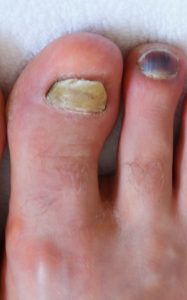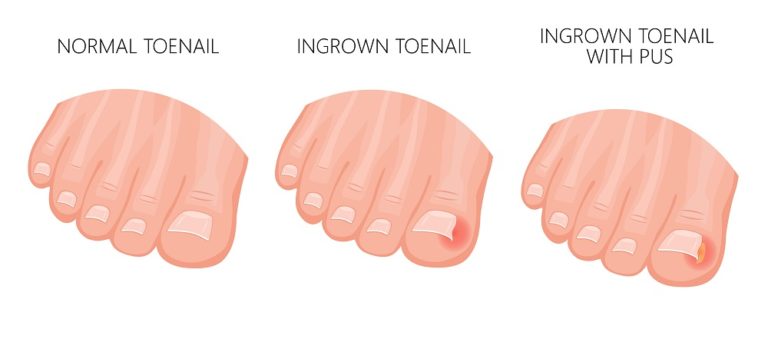Expert Foot & Ankle Treatment from Michigan’s #1 Podiatrist - Balance Foot & Ankle Specialist
Trusted Ingrown Toenail Specialists in Howell & Bloomfield
Expert Care for Ingrown Toenails at Balance Foot & Ankle Specialists
Ingrown toenails can be more than just a nuisance—they can lead to serious discomfort, infection, and mobility issues. At Balance Foot & Ankle Specialists in Michigan, we offer expert podiatric solutions tailored to address the root cause of ingrown toenails. Whether it’s a recurring issue or a one-time concern, our team, led by Dr. Tom Biernacki, delivers advanced, compassionate care to restore your comfort and foot health.
Ingrown Toenail Questions
Does Podiatrist Ingrown Toenail Cost?
- The cost for an ingrown toenail removal by a podiatrist is usually covered or minimal if you have insurance.
- Most major insurance plans cover ingrown toenail removal, and we take most major plans at a prime foot and ankle specialist.
- This includes Medicare, Blue Cross Blue Shield, and many other plans.
Do Podiatrists Deal with Ingrown Toenails?
- Yes, podiatrist to deal with ingrown toenails.
- We can perform permanent ingrown toenail surgery in the office.
- This procedure can be done on your first appointment and takes about 15 minutes to perform after being retracted.
- We do provide local anesthesia, which provides minimal pain for the rest of the day.
- After the anesthesia wears off, the patient is usually feeling better after having their ingrown toenail removed.
Podiatrist Ingrown Toenail Tools:
- We use sterilized stainless steel tools with prescription medication for treatment.
- It would be difficult to use podiatrist tools inside the house because the key to ingrown toenails is diagnosing and providing anesthesia.
- We do use sterile ingrown toenail removal tools that are sterilized and autoclaved before each usage.
- Anesthesia like injectable lidocaine or bupivacaine is not readily available for injections outside of the doctor’s office.
We FIX & Deal with Ingrown Toenails

What is the Podiatrist Ingrown Toenail Surgery Cost?
- The cost for podiatrist ingrown surgery removal is usually minimal if you have insurance plans.
- Most major insurances like Medicare Blue Cross Blue Shield do cover ingrown toenail surgery procedures.
How Do Podiatrists Remove Ingrown Toenails?
- Our podiatrist and foot doctors can perform permanent ingrown toenail removal surgery on your first visit.
- If you have an ingrown toenail infection or pain, this is considered an emergency, and we recommend you call our office immediately.
- What we do is cleanse the skin with iodine or another anti-septic material.
- We then use local anesthesia to anesthetize the toe.
- This means you will have much sensation in the toe for at least about 6-8 hours.
- Once the toe has minimal sensation, we can remove the toenail and apply some medication to the corner to ensure the ingrown toenail does not return.
- At this point, we can sometimes perform a biomechanical exam to see why this ingrown toenail happens in the first place.
- In this way, podiatrists can help with ingrown toenails.
- If you have work the next day or the day after, you can usually return with less space than he did before the ingrown toenail.
- It is rare for people to take extended time off beyond a day or two, although there are never any guarantees in medicine.
Should I See a Dermatologist or Podiatrist for an Ingrown Toenail?
- We are biased, but as podiatrists and foot doctors, we see thousands and thousands of toes and ingrown toenails during our careers.
- We can perform this procedure for a low cost safely and get you back on your feet as soon as possible.
- We also make an effort to have as short of the waitlist as possible, and we prioritize getting ingrown toenails in for as soon as possible.
- If you are at home and have an ingrown toenail, we also benefit from providing home care visits.
- If you need an antibiotic, we also performed podiatrist telehealth appointments.
Podiatrist Ingrown Toenail Removal


What are The Common Causes of Ingrown Toenails?
- If you injure your toenail
- If you wear tight, pointed shoes that crowd your toenails
- If you have unusually curved toenails
- If you cut your toenails very short and not straight across
- Engaging in activities where repeated pressure is put on toes for long periods such as ballet, soccer, football, kickboxing
What are The Symptoms of an Ingrown Toenail?
- You may develop pain and tenderness along the sides of the toenail
- Redness around the toenail
- Swelling in the surrounding tissue (edema due to inflammation and fluid buildup)
- Signs of infection – oozing of pus, you may feel hot and shiver
Ingrown Toenail, Dermatologist or Podiatrist?
Although many doctors, including Dermatologists and family physicians, can treat an ingrown toenail, Podiatrists are the best qualified medical professionals to treat this condition. As they are foot and ankle specialty doctors, they will offer you complete foot care.When to See a Podiatrist for Ingrown Toenails?
You may have tried several home remedies, but the condition may not subside or may worsen with time. Then it is time to seek help. If your pain is severe and uncomfortable and the swelling and redness spread, seek help from a podiatrist. You may see pus around the toenail, which points towards infection in the surrounding tissue. You might get a fever with chills because of the ongoing infection. If you have diabetes or have problems with blood circulation, you are at a greater risk of developing complications.
Ingrown toenails can cause complications such as;
- Bone Infection – If the infection is not treated, the underlying bone can get infected too. This is especially seen in patients with diabetes because of poor blood flow and loss of sensation.
- Gangrene – If left untreated, tissue death (gangrene) can occur, resulting in amputation and loss of a toe.
Therefore, you have to take an ingrown toenail seriously. Seek help from your podiatrist early, especially if you have diabetes or any other condition which leads to poor blood flow in your feet.
How Will Your Podiatrist Deal With Ingrown Toenails?
Your podiatrist can diagnose an ingrown toenail clinically based on your history and symptoms. They will do a complete physical examination of your toenail and the surrounding tissue. Sometimes blood investigations such as FBC and CRP will be ordered to determine the severity of infection.
An X-Ray will be helpful to see how deep your nail has grown into the skin, especially if there is an infection. It will also reveal whether your ingrown toenail was caused by injury. The X-Ray will show if the ingrown toenail is infected and complicated with infection passing to your underlying bone.
How Do Podiatrists Treat Ingrown Toenails?
Depending on the severity, treatment options may vary.
- By lifting your toenail
If your toenail is only slightly ingrown, your podiatrist will carefully lift the edge of the ingrowing toenail and place cotton, a splint, or dental floss under it. Nail lifting is done when there is pain and redness but no pus and other features of infection. This will separate your toenail from the overlying skin while helping it to grow above the skin edge. You will be taught to replace the material daily after soaking your toes.
- Partial removal of the toenail (Partial nail avulsion)
If the ingrown toenail is more severe with pain, redness, and pus, your podiatrist will trim and remove the ingrown portion of your toenail. They will temporarily numb your toe by injecting an anesthetic so that this procedure is pain-free.
- Removal of the nail along with surrounding tissue
If you have repeated problems with your toenail, your podiatrist will remove a part of the nail, along with some underlying tissue of your nail bed. That part of the nail will not grow back following this procedure. A local anesthetic will be injected to relieve pain during the procedure.
Complete nail plate avulsion means removal of the whole ingrown toenail. It may take 3 -4 months for the nail to regrow after complete removal.
Following surgery, your toe will be bandaged. You need to keep your foot raised, rest at home for 1- 2 days, and wear special footwear to heal your toe properly. Once the bandage is removed, wear open shoes and daily soak your feet in warm saltwater.
Apart from the surgical options, a podiatrist will use LASER, chemicals, or other methods to treat ingrown toenails.
- Treatment of infection – Infection will be treated with topical antibiotics or even oral antibiotics, depending on the severity of the infection.
- Pain relief – medications will be prescribed by your podiatrist to ease your pain, such as acetaminophen (Tylenol), Ibuprofen (Advil), or Naproxen (Aleve)
Podiatrist Tools for Ingrown Toenails:
Toenail removal sets are comprising of all necessary tools to perform a toenail surgery. These tools are specially made of surgical-grade stainless steel to be used by professionals. This kit is called ‘Toenail Surgery pack,’ and it contains;
- Scalpel Handle #3
- Elevator
- Curette Excavator 1.5/2.0mm with Holes
- Micro-Blade Scalpel Handle
- Adson Forceps 12cm
- Mosquito Forceps 12.5cm Straight
- Mosquito Forceps 12.5cm Curved
- Cuticle Nipper Double Spring Back Lock
- Adson Brown Forceps 12cm 7:8
- Nail Splitter 12.5cm English Anvil
- Platypus Nail Pulling Forceps 14cm Standard
- Platypus Nail Pulling Forceps 14cm Narrow
- Lister Bandage Scissors 17cm
- Iris Scissors 11cm TC Curved
These products are reusable and can be sterilized.
Here are some tools considered must-have items to perform an ingrown toenail removal surgery by podiatrists.
- Nail Clippers Set – 2 Pack Stainless Steel.
- Podiatrist Toenail Clippers, Professional Thick & Ingrown Toe Nail Clippers.
- Nail and Cuticle Oil.
- 8Pcs/set Ingrown Toenail Tools Kit.
- Ingrown Toenail File and Lifters.
Podiatrist Ingrown Toenail Cost:
Ingrown toenail treatment is typically covered by health insurance. For those without health insurance, ingrown toenail treatment with a podiatrist can be approximately $100 to $200 to take care of your ingrown toenail pain.
How Can a Podiatrist Fix an Ingrown Toenail?
After complete care of your ingrown toenail, your podiatrist will give you advice on the prevention of further recurrences;
- How to trim your nails straight across and not too short.
- Regarding lifestyle changes and home remedies – such as soaking your feet in warm water, pain relief, etc.
- Advice regarding shoes – how to select shoes that fit well and not crowd your toes.
- How to check your feet for early signs of ingrown toenails or any other foot problems.
If you cannot do this on your own, your podiatrist is always there to help when it comes to ingrown toenails or any other foot problem, from trimming your nails to complete foot care.
Say Goodbye to Toenail Pain—Schedule Your Evaluation Today!
Don’t let ingrown toenail pain disrupt your life. At Balance Foot & Ankle Specialists in Michigan, Dr. Tom Biernacki offers fast, gentle, and lasting solutions to help you walk comfortably again. Schedule your appointment today and take the first step toward pain-free feet.
How Does a Podiatrist Fix an Ingrown Toenail?
- Using sterilized tools and local anesthesia, we can painlessly and quickly perform an ingrown toenail procedure.
- This takes about 15 minutes in the office, and it usually feels better afterward than before the procedure after the anesthesia wears off.
- Give our office a call to find out more details. But generally, these are well-covered procedures by insurance that are safe and have excellent results.
Can a Podiatrist Cut Out Ingrown Toenails Without Anesthesia?
- If it does not appear that anesthesia is needed, sometimes we can cut out the toenail without having to utilize anesthesia.
This can result in excellent pain relief with minimal effort or cost.
Should I See No GP or Podiatrist for an Ingrown Toenail?
- We are biased as podiatrists, but we believe we can provide excellent ingrown toenail removal surgery care.
- We are trained in the latest techniques and the best local anesthesia to provide painless treatment.
- In this way, we can take great care of your ingrown toenail. We also provide home care appointments and tell health appointments for those who need them.
When To Go To a Podiatrist for an Ingrown Toenail?
- If you are reading this and worried about your ingrown toenail, it is never too early to see a podiatrist.
- We make emergency appointments to get you in as quickly as possible, and this procedure takes 15 minutes.
- If you have an eligible insurance plan, we take most insurance plans, which is a very cost-effective treatment.
- If you are in Michigan, call us soon for an appointment!
How Do Podiatrists Treat Ingrown Toenails?
Podiatrists can perform different treatment options for your ingrown toenail.
- 1) This means that the ingrown toenail can be trimmed.
- 2) It means the local anesthetic can also be used similar to a dentist numbing a tooth prior to a procedure, at this point the toenail can be resected back and treated permanently.
- 3) A third option also exists which means a permanent ingrown toenail removal surgery can be performed.
Best Podiatrist Near Me for Ingrown Toenail Removal
We service most major cities in the metro Detroit and southeast Michigan region. These areas include Oakland county, Macomb county, Warren county, Livingston county and Washtenaw county.Areas We Service:
The podiatrists & foot doctors of Balance Foot & Ankle Specialists are available for in office visits, home care and telehealth for the following locations:
Ingrown Toenail Podiatrist Office Pictures
In-office, Surgeries Podiatrists Services
Frequently Asked Questions About Ingrown Toenails
An ingrown toenail occurs when the edge of your toenail grows into the surrounding skin, causing pain, redness, or infection.
Podiatrists may lift the nail, remove part of it, or perform a minor procedure to prevent the nail from growing back incorrectly.
Mild cases can be managed with warm soaks and proper nail care, but persistent or painful cases should be treated by a professional.
Genetics, improper nail trimming, and repeated trauma to the toe are common causes of chronic issues.
No. Local anesthesia is used during the procedure, so patients typically feel minimal discomfort.
Most patients recover within 1 to 2 weeks, though complete healing may vary depending on the procedure.
Yes. Poor circulation and reduced healing can lead to serious complications. Diabetics should seek prompt podiatric care.
Cut nails straight across, wear properly fitted shoes, and avoid cutting nails too short.
Our clinic offers expert, comfortable care using advanced techniques. Dr. Tom Biernacki ensures each patient gets a personalized plan for fast relief and lasting results.

